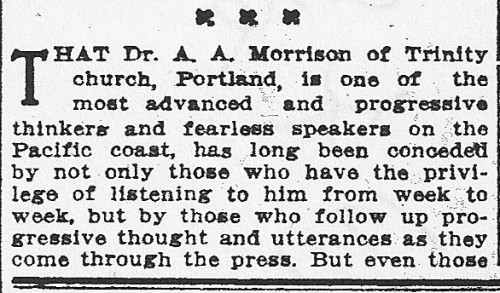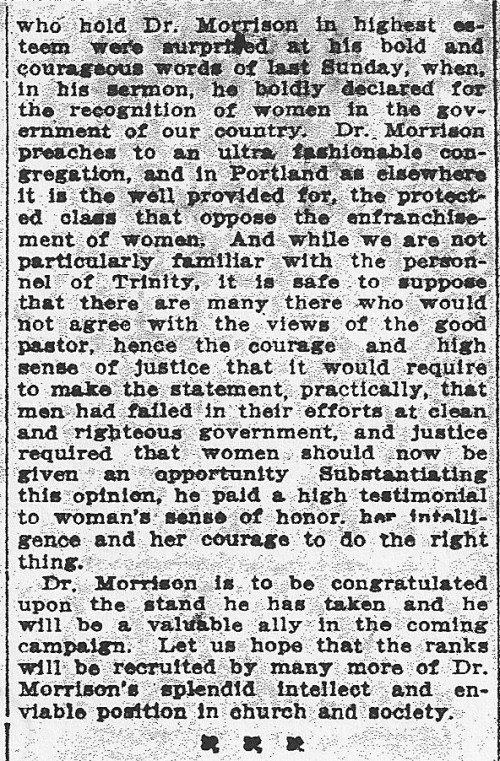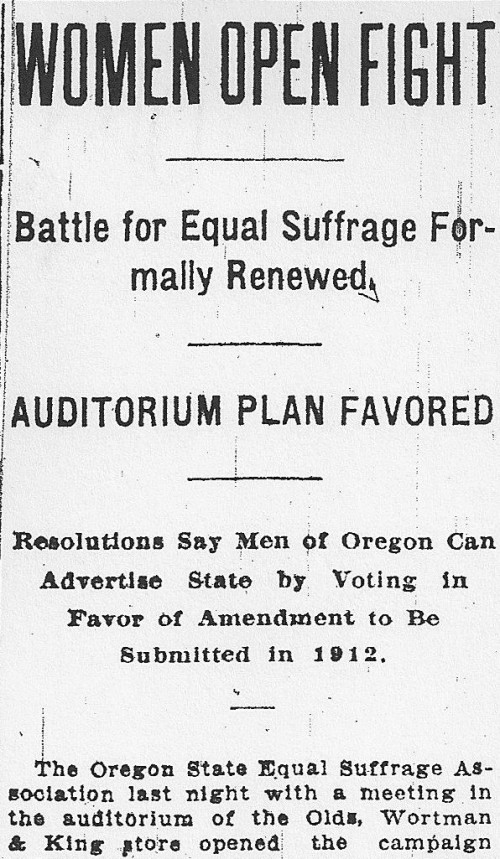September 1911: Abigail Scott Duniway Portrait Unveiled With A Suffrage Speech
On September 16, 1911 supporters of the votes for women movement gathered at the Portland Hotel for the unveiling of a portrait of Abigail Scott Duniway by the artist Edwin D. Betts.
Several members of the Oregon State Equal Suffrage Association spoke, and Duniway then addressed the crowd, recalling early days in Oregon. “Mrs. Duniway barely hinted at the suffragist movement in her brief speech,” the Oregonian reported, “but by request of those present she was induced to rise again and speak on that subject.” It would appear that Duniway wanted a quiet campaign (her “still hunt”). But others wanted more.
In her second speech Duniway praised those Oregon men who supported equal suffrage and said she expected California women, where a ballot measure to enfranchise women was on the November 1911 ballot, would be successful in gaining the vote. She also “expected Oregon to join the galaxy of free states next year” with its ballot measure slated for November 1912.
Duniway compared the achievement of votes for women to a horse who was afraid of an open umbrella but loved apples. The horse’s owner worked each day to overcome its fear by “fixing an apple on the stub at the top of the umbrella and offering it to the horse.” Each time the owner opened the umbrella a bit more until the horse had no fear of an open umbrella.
“In like manner, she said, men would soon learn not to be afraid of woman’s suffrage. She said that women did not want to rule over men, as they might imagine, but were asking only for their individual rights and liberties.”
And, she concluded, “‘a man who could be ruled by a woman would not be worth corralling after she had driven him home.’”
The Abigail Scott Duniway Papers at the University of Oregon include several letters from Betts to Duniway. The Oregonian article suggests that the portrait went to the National Portrait Gallery in Washington but a search of the gallery’s website does not yield results. The image of the portrait accompanying the Oregonian article is of poor quality as preserved for us on microfilm, but indicates a seated portrait of the leader at 77. If you have additional information about this portrait please do share it with Century of Action.

“Honor Paid Leader: Mrs. Abigail Scott Duniway’s Picture Unveiled,” Oregonian, September 17, 1911, 10.
—Kimberly Jensen
Want to read more articles from Oregon suffrage campaigns? Click here
Permalink
August 1911: Municipal Suffrage in Portland: A “Long Pull, A Strong Pull and A Pull Altogether”
One hundred years ago this month, in her August 13, 1911 “Women’s Clubs” column for the Oregon Journal, activist Sarah A. Evans reported on the petition drive by Portland women to “have a municipal suffrage clause incorporated into the new city charter, which will give all the citizens, irrespective of sex, the right to vote” in city elections.
Many votes for women activists around the world worked for the right to the ballot in stages—voting in school elections (taxpaying women in Oregon achieved this in 1878) and voting in municipal (city) elections. They drew upon cultural views that women had a “stake” in school and city affairs, particularly taxpaying women. This was also a strategy, a partial step on the path to full voting rights. Canadian women, women in England, New South Wales, Australia, New Zealand, Norway and Denmark and women in the U.S. state of Kansas had limited but important access (usually through taxpaying or marital status) to voting in city matters by the time of the Portland campaign.
Portland did not enact a new city charter until 1913 and by that time women had achieved full voting rights statewide in the election of November 1912. Yet this campaign for city suffrage in the summer of 1911 suggests some important things about the views and goals of Portland women in the broader movement for votes and rights.
First: they used petitions. Susan Zaeske argues in Signatures of Citizenship: Petitioning, Antislavery, and Women’s Political Identity, that women who participated in petitioning the government to end slavery in the U.S. in the nineteenth century increasingly saw their act of signing a petition as a political one and viewed themselves as citizens as a result. Portland women were exercising their right to petition during this campaign for municipal suffrage and Evans emphasized their role as citizens. The petition campaign was “to give all citizens, irrespective of sex” this right. Portland women were using the civic tools available to them before full voting rights, one of which was the petition.
Second: the campaign showed unity among women. The suffrage movement in Oregon by 1911 suffered from conflict and division. Evans indicated that a strength of this municipal suffrage campaign was “because of its united effort. It is not the work of one organization, faction, or individual, it is simply ‘the women’ . . .” “Now is the time,” she wrote, for “women to make a ‘long pull, a strong pull and a pull altogether.’” Such unity would symbolize strength and be a powerful tool for the upcoming state campaign for full suffrage in 1912.
Third: it reflected the view held by Evans and other supporters that the vote would lead to better communities and that women had common interests at stake. “Anyone interested in the cause,” Evans wrote, “—and what woman should not be willing to have a vote that she might uphold the hands of the officials who are striving so hard to eliminate the white slave traffic [prostitution] and other evils that touch women so closely?—can secure petitions . . .”
Fourth: women were interested and participated in large numbers. The 1908 and 1910 suffrage campaigns were not supported by many Oregonians, but the 1912 campaign would see a rebirth of participation and interest. Evans suggests that this was already evident in the Portland municipal suffrage petition drive. “The offer for volunteer work in getting the petitions signed is rapidly depleting the supply,” Evans noted. And “many are sending in regrets that women outside of the city cannot sign the petitions.”

Sarah A. Evans, “Women’s Clubs,” Oregon Journal, August 13, 1911, 5:5.
—Kimberly Jensen
Additional Reading:
P. Orman Ray, “Woman Suffrage in Foreign Countries,” American Political Science Review 12 no. 3 (August 1918): 469-474.
Susan Zaeske, Signatures of Citizenship: Petitioning, Antislavery, and Women’s Political Identity (Chapel Hill: University of North Carolina Press, 2003)
Want to read more articles from Oregon suffrage campaigns? Click here
Permalink
July 1911: The Fern Hobbs Enigma
On July 19, 1911, less than two months after the formal opening of the 1912 woman suffrage campaign in Oregon, the Medford Mail Tribune reported that Fern Hobbs, chief clerk for Oregon Governor Oswald West, “hoped the time would never come when women were enabled to vote.” Hobbs “would simply dread such a time,” she told reporters, “And wouldn’t I look nice as a candidate for governor. No we women have troubles enough now without worrying over politics.”
Hobbs opposed votes for women yet her boss, Governor West, endorsed it, and would play a significant role in the successful 1912 campaign.

“Miss Hobbs Spurns Votes for Women,” Medford Mail Tribune, July 19, 1911, 6.
Yet as we learn from the excellent Oregon Encyclopedia biography of Fern Hobbs by Gary Dielman and John de Ferrari, she was a woman whom we might expect to be a strong supporter of woman suffrage.
Hobbs attended Willamette Law school while working as chief clerk for Governor West and, when she received her law degree in 1913, he appointed her his private secretary at an unprecedented salary of $3,000. She worked with federal officials in Washington, D.C., to settle Oregon land issues, was West’s emissary to Copperfield in Baker County and brought his declaration of martial law there in 1914, and served on the Oregon Industrial Accident Commission. During the First World War she served in France with the Red Cross and after the war with the Y.M.C.A. and the U.S. Army of Occupation in Germany. She was a longtime secretary to the business manager of the Oregon Journal.
Yet as Dielman and de Ferrari note, Hobbs “was a symbol of what Oregon women could accomplish” but while “an ardent feminist in her beliefs, Hobbs did not actively participate in the women’s suffrage movement.”
What are we to make of the Fern Hobbs enigma? Her story certainly lets us know that the quest for votes for women was not characterized by a simple divide between active supporters who favored women’s rights and opponents who believed that women should not be educated or employed. It also suggests that the vote, while very important to women’s full citizenship, was not and is not the only factor in achieving equality and empowerment.
It also would be most instructive to know whether Fern Hobbs changed her mind about the importance of voting after the successful 1912 campaign.
Visit the Oregon Encyclopedia entry for Hobbs by Gary Dielman and John de Ferrari to learn more about her life and to view the spectacular images courtesy of de Ferrari.
We in Oregon have an incredible new tool available to us—the Oregon Digital Newspaper Program. Karen Estlund, Director, and Project Manager Jason Stone, supervise a staff who are digitizing Oregon newspapers so that they are searchable on the web. I retrieved the Medford Mail Tribune article featured this month from the project site. Thanks Jason!
—Kimberly Jensen
Want to read more articles from Oregon suffrage campaigns? Click here
Permalink
June 1911: Sarah Evans Applauds Reverend A. A. Morrison’s Support of Woman Suffrage
One hundred years ago this month in her June 25, 1911 “Women’s Clubs” column for the Oregon Journal suffragist Sarah Evans praised Dr. A.A. Morrison of Portland’s Trinity Episcopal Church for “his bold and courageous words of last Sunday, when, in his sermon, he boldly declared for the recognition of women in the government of our country.” Evans congratulated him “on the stand he has taken” and claimed him as a “valuable ally in the coming campaign” to achieve women’s voting rights in the state.


Sarah A. Evans, “Women’s Clubs,” Oregon Journal, June 25, 1911, 5:5
This entry in Evans’s “Women’s Clubs” column is important and illustrative for what it tells us about this stage of the Oregon and national suffrage campaigns. First, this entry underscores the class divide in the votes for women movement as many elites (women and men) opposed woman suffrage. Evans noted that “Dr. Morrison preaches to an ultra fashionable congregation, and in Portland as elsewhere it is the well provided for, the protected class that oppose the enfranchisement of women.” The Portland Woman’s Club, of which Evans, Esther Pohl Lovejoy and other suffragists were members, would only formally endorse woman suffrage in early 1912. Other Oregon suffragists, Pohl Lovejoy included, would join Evans in challenging the arguments of this “protected class” of anti-suffragists. But in the 1912 campaign some wealthy Portlanders would cross class lines to work for the women’s ballot, among them Josephine Hirsch, who founded the Portland Equal Suffrage League.
The entry also underscores the view held by Evans and other suffragists that women’s different experiences (and for some, what they believed to be women’s different “nature” from men) were an important reason why they should have a full voice in government. As Evans noted, Morrison had “made the statement, practically, that men had failed in their efforts at clean and righteous government, and justice required that women should now be given an opportunity. Substantiating this, he paid a high testimonial to women’s sense of honor, her intelligence, and her courage to do the right thing.”
Evans lauded Morrison as “one of the most advanced and progressive thinkers and fearless speakers on the Pacific coast.” She concluded: “Let us hope that the ranks will be recruited by many more of Dr. Morrison’s splendid intellect and enviable position in church and society.”
In June 1911 there were still many more allies to be won for the cause. But Evans counted Morrison as an important ally and noted his courage to challenge his elite congregation in the city to support the votes for women campaign.
—Kimberly Jensen
Want to read more articles from Oregon suffrage campaigns? Click here
Permalink
May 1911: The Oregon Equal Suffrage Association Opens the 1912 Woman Suffrage Campaign
On May 27, 1911 members of the Oregon Equal Suffrage Association (OESA) met in the Olds, Wortman & King Department Store and “formally renewed” the campaign for votes for women that would culminate in victory on November 5, 1912. OESA members had filed enough signatures to complete an initiative petition in December 1910. Now Abigail Scott Duniway, president of the OESA, announced that the campaign had begun.
Members passed the following resolution:
“Resolved, That the farthest-reaching and most economical and enterprising advertisement the men of Oregon can adopt for calling the world’s attention to our young and vigorous state and its many and magnificent resources, will be to vote ‘yes’ on the pending equal suffrage amendment on the fifth day of November, 1912.
“Resolved, That the movement for the enfranchisement of women is a world’s movement, non-political, and non-partisan in aim and character; and it welcomes to its ranks every man and woman in Oregon who believes in the fundamental principles of liberty, as embodied in the Declaration of Independence and the Constitution of the United States, regardless of their affiliation with individual beliefs in any party, sect or creed.”
The meeting and resolution reflect themes that would continue to be a part of the 1912 campaign. One was cooperation across state lines and assistance from women who had already won the right to vote. Washington suffragist Flora McKinney was there to let Oregon women know that Washington women, who had achieved the vote in 1910, “stood ready to assist the women of their sister state to gain their point at the next election.” Another theme was the emphasis on votes for women as a progressive measure that would promote Oregon.


“Women Open Fight,” Oregonian, May 28, 1911, 7.
—Kimberly Jensen
Want to read more articles from Oregon suffrage campaigns? Click here
Permalink

